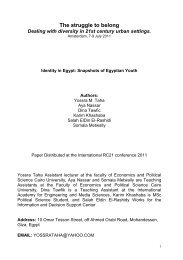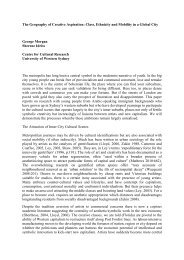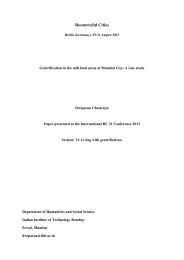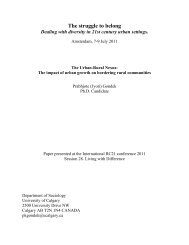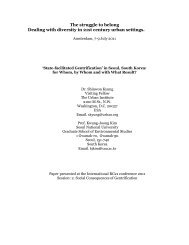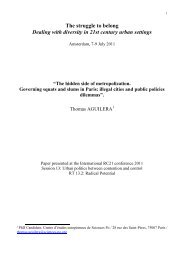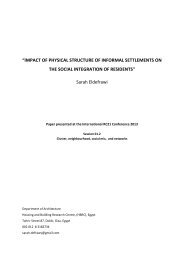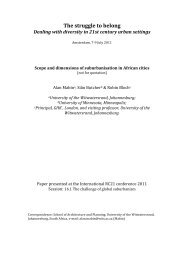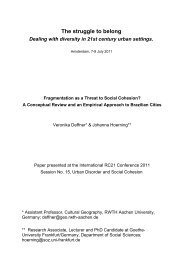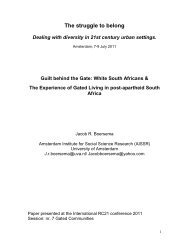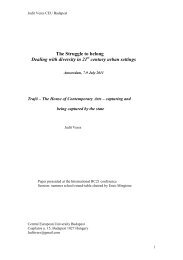The struggle to belong Dealing with diversity in 21st ... - Rc21.org
The struggle to belong Dealing with diversity in 21st ... - Rc21.org
The struggle to belong Dealing with diversity in 21st ... - Rc21.org
Create successful ePaper yourself
Turn your PDF publications into a flip-book with our unique Google optimized e-Paper software.
<strong>The</strong> <strong>struggle</strong> <strong>to</strong> <strong>belong</strong><br />
<strong>Deal<strong>in</strong>g</strong> <strong>with</strong> <strong>diversity</strong> <strong>in</strong> <strong>21st</strong> century urban sett<strong>in</strong>gs.<br />
Amsterdam, 7-9 July 2011<br />
Ethnography as a Method for the Exploration<br />
of the Social Production of Space<br />
N<strong>in</strong>a Schuster (Dortmund University)<br />
Paper presented at the International RC21 conference 2011<br />
Session: nr. 21, Ethnographic <strong>in</strong>terventions<br />
Dr. N<strong>in</strong>a Schuster<br />
Technische Universität Dortmund<br />
Faculty of Spatial Plann<strong>in</strong>g, Urban and Regional Sociology<br />
August-Schmidt-Str. 10, GB III<br />
D-44227 Dortmund, Germany<br />
Tel. +49-231-755 23 70<br />
Fax +49-231-755 22 45<br />
n<strong>in</strong>a.schuster@tu-dortmund.de
Introduction<br />
In this paper I am explor<strong>in</strong>g the method of ethnography for the research of the everyday<br />
production of space. My research has been especially <strong>in</strong>terested <strong>in</strong> the connections of the<br />
construction of space and the construction of sex, gender (and sexuality). I asked how space is<br />
produced <strong>in</strong> everyday life and <strong>in</strong> social practices, and how gender and sexuality are, like other<br />
social dimensions of difference, woven <strong>in</strong><strong>to</strong> space and its social construction consider<strong>in</strong>g that<br />
the production of space is a process which is shaped by heteronormativity.<br />
<strong>The</strong> concept of heteronormativity emerged <strong>in</strong> queer/fem<strong>in</strong>ist poststructuralist theories <strong>in</strong> the<br />
1990ies. It assumes that heterosexuality is a strong, omnipresent norm which imposes persons<br />
<strong>to</strong> decide between two clearly differentiated genders. Also it assumes that people are attracted<br />
only <strong>to</strong> the opposite gender. Heteronormativity organizes society as an a-priori category of<br />
<strong>in</strong>terpretation which implies a bundle of norms of behaviour (Wagenknecht 2007: 17).<br />
My example for the exploration of the everyday production of space <strong>in</strong> social practices <strong>in</strong> the<br />
context of the relations of gender, sexuality and space is an ethnographic field study I carried<br />
out from 2004 <strong>to</strong> 2009 <strong>in</strong> the subcultural scene of drag k<strong>in</strong>gs and transgender <strong>in</strong> German<br />
cities, especially <strong>in</strong> Berl<strong>in</strong> and Cologne as well as <strong>in</strong> the small university <strong>to</strong>wn Marburg and <strong>in</strong><br />
the Ruhr Region.<br />
<strong>The</strong> scene of drag k<strong>in</strong>gs und transgender became more visible while issues of transgender and<br />
the rejection of the heteronormative matrix were made a more important <strong>to</strong>pic on a practical<br />
level as well as on a theoretical level, especially <strong>in</strong> the context of queer transgender<br />
movements and queer theory s<strong>in</strong>ce the mid-1990s (Fe<strong>in</strong>berg 1997, Wilch<strong>in</strong>s 1997, Stryker<br />
1998, Volcano/Halberstam 1999, Butler 2004). Till now, there is not much empirically based<br />
research done on transgender and drag k<strong>in</strong>gs (exceptions are the studies by Halberstam 1998,<br />
Hasten 1999, Doan 2007, Schirmer 2010). My ethnographic study (Schuster 2010) represents<br />
a new approach <strong>to</strong> the issue, as it undertakes a multi-perspective exploration of the scene, of<br />
its socio-his<strong>to</strong>rical and spatial contexts and its place mak<strong>in</strong>g. It takes account of people‟s<br />
social practices of (un)do<strong>in</strong>g gender b<strong>in</strong>ary, of the materialities of their practices and places<br />
and of the underly<strong>in</strong>g norms <strong>in</strong> the scene organiz<strong>in</strong>g <strong>in</strong>clusion and exclusion.<br />
An important aspect of the researched scene is that the persons who form the scene are quite<br />
eager <strong>to</strong> reflect on the social construction of sex and gender along <strong>with</strong> the heteronormative<br />
conditions of society. This is becom<strong>in</strong>g manifest especially <strong>in</strong> their practices. Drag k<strong>in</strong>gs are<br />
often persons who are socialized as women but can‟t identify <strong>with</strong> the ascribed sex and gender<br />
“woman” for different reasons. Some of them test out the frontiers of gender b<strong>in</strong>ary <strong>in</strong> a<br />
playful way. <strong>The</strong>y are do<strong>in</strong>g this <strong>in</strong> everyday sett<strong>in</strong>gs as well as <strong>in</strong> the safer sphere of the<br />
scene where some also perform on stage. By perform<strong>in</strong>g mascul<strong>in</strong>ity as well as ambiguous<br />
genders, they confront the audience <strong>with</strong> the processes of the social construction of sex and<br />
gender. Moreover, they expose that the concept of an authentic and real gender is quite brittle<br />
and that there exist a range of possible genders.<br />
Some, not all drag k<strong>in</strong>gs, feel quite familiar <strong>with</strong> the heterogeneous group of transgender. <strong>The</strong><br />
concept “transgender” is used here just as <strong>in</strong> many subcultural contexts as an open term for all<br />
people who transgress gender b<strong>in</strong>ary, some <strong>with</strong> the idea of a transgression from one pole <strong>to</strong><br />
the other (female <strong>to</strong> male or male <strong>to</strong> female), some <strong>with</strong> the <strong>in</strong>tention of not <strong>belong</strong><strong>in</strong>g <strong>to</strong> one<br />
of both at all but feel<strong>in</strong>g and liv<strong>in</strong>g <strong>in</strong>-between.<br />
“<strong>The</strong> term transgender has been appropriated by some gender variant <strong>in</strong>dividuals as an<br />
umbrella term referr<strong>in</strong>g <strong>to</strong> people who feel the need <strong>to</strong> contravene societal expectations and<br />
express a gender variant identity on a regular basis. <strong>The</strong>se people <strong>in</strong>clude: cross-dressers, drag<br />
queens, drag k<strong>in</strong>gs and pre-operative, post-operative, and non-operative transsexuals.“ (Doan<br />
2007: 58 f.)<br />
2
In the course of my research, it became obvious that the concept “drag k<strong>in</strong>g” is <strong>in</strong>separable<br />
from the concept “transgender” or “trans man”. Respectively, the spaces of drag k<strong>in</strong>gs and<br />
transgender are connected <strong>with</strong> each other <strong>in</strong> various ways while also <strong>in</strong>tersect<strong>in</strong>g <strong>with</strong> the<br />
spaces of lesbian, gay and “queer” scenes and other alternative scenes like the scene of the<br />
political left and the <strong>in</strong>dependent cultural scene. This was my reason <strong>to</strong> name the researched<br />
scene quite openly the “drag k<strong>in</strong>g and transgender scene”. Thus, I <strong>in</strong>vestigated the coherences<br />
<strong>with</strong><strong>in</strong> the scene as well as its connections <strong>with</strong> other subcultural scenes, places and spaces.<br />
Ethnography as a sociological method<br />
In my explorative research on the social production of space, ethnography has been an<br />
approach that opened up new perspectives, on the one hand on the researched subject of a<br />
subcultural community and its spaces, and on the other hand, on a more abstract level, on the<br />
multi-faceted production of space <strong>in</strong> the context of the construction of gender and sexuality.<br />
Let me say some words about the methodology of ethnography. Why is ethnography an<br />
adequate method for the research of the everyday production of space? As subject and<br />
research questions on the production of space <strong>in</strong> social practices had not been an issue of<br />
empirical research before, an explor<strong>in</strong>g and <strong>in</strong>terpretative research perspective seemed <strong>to</strong> be<br />
appropriate. Characterized by an understand<strong>in</strong>g perspective, ethnography <strong>in</strong>tends <strong>to</strong><br />
reconstruct the sense of social realities <strong>with</strong><strong>in</strong> the knowledge and the practices of <strong>in</strong>dividuals<br />
and groups which <strong>in</strong>cludes also explor<strong>in</strong>g the relevance they assign <strong>to</strong> them (Hitzler 2000:<br />
22 f.).<br />
<strong>The</strong> ga<strong>in</strong> of ethnography, thus, is the ability <strong>to</strong> reconstruct the sense of social realities by<br />
analyz<strong>in</strong>g social patterns of <strong>in</strong>teraction and communication as well as patterns of<br />
<strong>in</strong>terpretation and structures of sense. Tak<strong>in</strong>g on the perspective of the social ac<strong>to</strong>rs of a social<br />
field, ethnographic research focuses on the <strong>in</strong>teractive practices. It produces a comprehensive<br />
approach <strong>to</strong> the logics of everyday practices. In consequence, ethnographical research consists<br />
of gett<strong>in</strong>g <strong>to</strong> know the research field and its particular logics from <strong>with</strong><strong>in</strong>.<br />
„<strong>The</strong>ir study [of everyday activities] is directed <strong>to</strong> the tasks of learn<strong>in</strong>g how members‟ actual,<br />
ord<strong>in</strong>ary activities consist of methods <strong>to</strong> make practical actions, practical circumstances,<br />
common sense knowledge of social structures, and practical sociological reason<strong>in</strong>g<br />
analyzeable; and of discover<strong>in</strong>g the formal properties of commonplace, practical common<br />
sense actions, ‚from <strong>with</strong><strong>in</strong>„ actual sett<strong>in</strong>gs, as ongo<strong>in</strong>g accomplishments of those sett<strong>in</strong>gs.“<br />
(Garf<strong>in</strong>kel 1967: vii-viii)<br />
<strong>The</strong> <strong>in</strong>ductive research perspective allows tak<strong>in</strong>g on logics from the social field and prevents<br />
<strong>to</strong> project theoretical views on<strong>to</strong> the subject. <strong>The</strong> purpose is <strong>to</strong> reconstruct the logics of the<br />
field <strong>in</strong> a critical way, from <strong>in</strong>side-out as well as <strong>with</strong> more distance, <strong>in</strong> order <strong>to</strong> open up the<br />
perspective for a macro-social <strong>in</strong>terpretation which is essential for critical sociological<br />
research <strong>with</strong> a focus on social relations of power and dom<strong>in</strong>ance. With<strong>in</strong> the process of<br />
research, it is therefore useful that the researchers spend alternate time <strong>in</strong> both fields: the<br />
researched field and the scientific community. An alternat<strong>in</strong>g of perspectives allows open<strong>in</strong>g<br />
the view from the micro perspective of the field <strong>to</strong> wider sociological contexts. This enables<br />
an empirically grounded theoretical <strong>in</strong>terpretation.<br />
Gender, sexuality and the social production of space – some theoretical thoughts<br />
Gender and sexuality<br />
<strong>The</strong> guid<strong>in</strong>g thesis of my research has been that drag k<strong>in</strong>gs and transgender who <strong>in</strong>corporate<br />
complex, his<strong>to</strong>rically new subject positions produce new spaces and new forms of liv<strong>in</strong>g<br />
3
challeng<strong>in</strong>g collectively the heteronormative concepts of sex, gender and desire. Queer/<br />
fem<strong>in</strong>ist theory discusses the already mentioned problem of the heteronormative social order.<br />
<strong>The</strong> concepts of sex, gender and sexuality go<strong>in</strong>g along <strong>with</strong> it are especially problematic for<br />
transgender and <strong>in</strong>tersex people and others who, like lesbian, gay and bisexual, do not fit <strong>in</strong><br />
the b<strong>in</strong>ary sex/gender order and the heterosexual norm. <strong>The</strong> analysis of the social organisation<br />
and the construction of sex, gender and desire as heteronormative is a quite important and<br />
<strong>in</strong>fluential orientation/paradigm <strong>in</strong> queer/fem<strong>in</strong>ist poststructuralist theory (Butler 1990; 1993).<br />
It questions identity categories as well as essentialist perspectives on sex, gender and desire<br />
and focuses on the analysis of processes of social differentiation shaped by social categories<br />
like class, gender, sexuality, ethnicity, ‟race‟, ability, age and others. It deals <strong>with</strong> social<br />
<strong>in</strong>equalities from a critical po<strong>in</strong>t of view and <strong>with</strong> a focus on relations of power and<br />
dom<strong>in</strong>ation.<br />
Space<br />
<strong>The</strong> presented research is also based on the discussion of theoretical concepts of space. If we<br />
assume that social reality is socially constructed (Berger/Luckmann 1966), also space and the<br />
order of sex, gender and sexuality is constructed by the members of the society. An important<br />
aspect of these constructions is formed by the actions of <strong>in</strong>dividuals, groups and <strong>in</strong>stitutions.<br />
As a part of the social structure, groups and <strong>in</strong>dividuals accept social ascriptions or distance<br />
themselves from them. In my research, I followed some ideas of the production of space<br />
concept by Henri Lefèbvre (1974) which I comb<strong>in</strong>ed <strong>with</strong> the concept of „synthesis<br />
capability‟ (Syntheseleistung) and „spac<strong>in</strong>g‟ by Mart<strong>in</strong>a Löw (2001). Thus I considered the<br />
social plac<strong>in</strong>g of <strong>in</strong>dividuals as a hierarchically organized, dynamic relational social process.<br />
In consequence, the distribution of space shows the position<strong>in</strong>g of <strong>in</strong>dividuals and groups<br />
<strong>with</strong><strong>in</strong> the social order. Conflicts over space make visible the hierarchical distribution of<br />
space as well as the possibilities of spatial redistributions. Thus, space is never static but, at<br />
least <strong>in</strong> parts, dynamic and negotiable <strong>in</strong> its arrangements and functions. Correspond<strong>in</strong>gly, the<br />
social practices that constitute space are variable as well.<br />
Space and sex/gender and sexuality<br />
When th<strong>in</strong>k<strong>in</strong>g the production of space and sex/gender <strong>to</strong>gether, norms that structure this<br />
relation become important. Research <strong>in</strong> queer geography (Valent<strong>in</strong>e 1993; 1996; 2002,<br />
Duncan 1996, Berlant/Warner 2002, Doan 2007) shows that <strong>in</strong> their production of space queer<br />
groups and <strong>in</strong>dividuals have <strong>to</strong> deal <strong>with</strong> the omnipresent heteronormative order shap<strong>in</strong>g their<br />
practices. Valent<strong>in</strong>e illustrates this <strong>with</strong> the follow<strong>in</strong>g words.<br />
„Heterosexuality is expressed <strong>in</strong> the way spaces are physically and socially organised; from<br />
houses <strong>to</strong> the workplace, restaurants <strong>to</strong> <strong>in</strong>surance companies, spaces reflect and support<br />
asymmetrical family units. <strong>The</strong> lack of recognition of alternative sexual identities means that<br />
places and organisations exclude lesbian and gay life-styles and so unconsciously reproduce<br />
heterosexual hegemony.” (Valent<strong>in</strong>e 1993: 410)<br />
Berlant/Warner add how <strong>in</strong> everyday practices the heteronormative order is reproduced. <strong>The</strong>y<br />
underl<strong>in</strong>e that these practices often are less associated as a part of a sexual culture, such as<br />
“pay<strong>in</strong>g taxes, be<strong>in</strong>g disgusted, philander<strong>in</strong>g, bequeath<strong>in</strong>g, celebrat<strong>in</strong>g a holiday, <strong>in</strong>vest<strong>in</strong>g for<br />
the future, teach<strong>in</strong>g, dispos<strong>in</strong>g a corpse, carry<strong>in</strong>g wallet pho<strong>to</strong>s, buy<strong>in</strong>g economy size, be<strong>in</strong>g<br />
nepotistic, runn<strong>in</strong>g for president, divorc<strong>in</strong>g, or own<strong>in</strong>g anyth<strong>in</strong>g „His‟ and „Hers‟”<br />
(Berlant/Warner 2002: 195). <strong>The</strong>se examples show how heteronormative concepts are woven<br />
<strong>in</strong><strong>to</strong> virtually all everyday actions.<br />
4
Valent<strong>in</strong>e (1993) considers that lesbian and gay people do not only “violate norms about<br />
sexual behaviour and family structure” (Valent<strong>in</strong>e 1993: 396). <strong>The</strong>y also deviate from the<br />
norm of mascul<strong>in</strong>e and fem<strong>in</strong><strong>in</strong>e behaviours that are considered as natural. She admits that<br />
these norms change over space and time, which means that sexuality is “not def<strong>in</strong>ed merely<br />
by sexual acts but exists as a process of power relations” (ibid.).<br />
„Like hous<strong>in</strong>g and the workplace, therefore, most social spaces are organised <strong>to</strong> reflect and<br />
express heterosexual sociosexual relations. In particular, hotels and restaurants are<br />
environments of <strong>in</strong>timacy associated <strong>with</strong> heterosexual romance, dat<strong>in</strong>g, and sex; and pubs and<br />
clubs are environments where women receive and are expected <strong>to</strong> be receptive <strong>to</strong> male sexual<br />
advances. Lesbians can therefore feel put of place because of the orientation of these places<br />
<strong>to</strong>wards heterosexual couples, or they are made feel out of place by the hostility of others who<br />
identify them as outsiders through their dress, body language, and dis<strong>in</strong>terest <strong>in</strong> men.“<br />
(Valent<strong>in</strong>e 1993: 406)<br />
This means that public spaces like streets and squares, but also shops, cafés and restaurants,<br />
are not asexual (Valent<strong>in</strong>e 1996: 146; 155). Rather the heterosex<strong>in</strong>g of space is a performative<br />
act which is naturalized through repetition and regulation. In this context, David Bell and Gill<br />
Valent<strong>in</strong>e speak of the hegemony of heterosexual social relations <strong>in</strong> everyday environments<br />
(Bell/Valent<strong>in</strong>e 1995: 7).<br />
Most authors <strong>in</strong> queer geography do not consider the b<strong>in</strong>ary gender order as be<strong>in</strong>g the primary<br />
problem of the heteronormative structure (here Valent<strong>in</strong>e is an exception when she mentions<br />
gender confusions and deviant gender behaviour as a substantial aspect of queer scenes). This<br />
means that most of the analyses of queer spaces and queer production of space focus on<br />
lesbian and gay spaces. This shows that the analysis of the lesbian and gay production of<br />
space is concentrated on sexual deviance from the norm. <strong>The</strong> majority of the so-called queer<br />
spaces implicate a stable basis of the b<strong>in</strong>ary gender order.<br />
A broader concept of queer and a different perspective on queer spaces is found <strong>in</strong> the work of<br />
Petra Doan (2007). Doan is <strong>in</strong>terested <strong>in</strong> transgendered perceptions of urban spaces and the<br />
relations of transgender and queer spaces <strong>in</strong> US-American cities. She shows that lesbian and<br />
gay spaces are always implicitly shaped by a dicho<strong>to</strong>mous view of gender. As most people<br />
have quite clear concepts of the appropriate gender behaviour, this may often exclude<br />
transgender. Doan‟s argues that “many lesbian and gay activists wished <strong>to</strong> present themselves<br />
as normal except for their selection of partners” (Doan 2007: 62) long<strong>in</strong>g <strong>to</strong> normalize their<br />
lives and <strong>to</strong> fit <strong>in</strong> a broad social context. <strong>The</strong>y therefore put a greater emphasis on gender<br />
normality. Lisa Duggan (2002) agrees <strong>with</strong> Doan when she assumes that gays and lesbians<br />
adopt more and more the heteronormative ideals of the couple and of a privatized <strong>in</strong>timacy.<br />
This new normalization has the consequence of new abjections and exclusions, which she<br />
names <strong>in</strong> the concept of homonormativity.<br />
Follow<strong>in</strong>g these analyses, my research is <strong>in</strong>terested <strong>in</strong> the <strong>in</strong>terruptions of the obviously<br />
omnipresent norm and <strong>in</strong> the opportunities of possible other spaces.<br />
Drag k<strong>in</strong>g and transgender productions of space<br />
I will present now some f<strong>in</strong>d<strong>in</strong>gs of my research that show how persons who do not fit <strong>in</strong> the<br />
heteronormative gender order produce their own spaces – <strong>in</strong> public and counter-public<br />
spheres. As already mentioned, my research has been focused on the production of space of<br />
the subcultural scene of drag k<strong>in</strong>gs and transgender <strong>in</strong> Germany. In their community, a part of<br />
people‟s social practice consists <strong>in</strong> the reflection of the social construction of gender and<br />
sexuality. My study Andere Räume [Other Spaces] (Schuster 2010) discusses the mutual<br />
constitution of space and gender (which <strong>in</strong>terferes <strong>with</strong> other categories of social<br />
5
classification as class, ethnicity and age) – <strong>in</strong> <strong>in</strong>teractions and social practices, <strong>in</strong> the<br />
<strong>in</strong>terconnection of persons <strong>with</strong> the urban quarter and <strong>with</strong> material th<strong>in</strong>gs as well as <strong>in</strong> the<br />
negotiations of norms and exclusions. I will show now some examples for the production of<br />
space at special places <strong>in</strong> the scene and discuss the importance of norms <strong>in</strong> this process.<br />
In the course of my research, I considered the drag k<strong>in</strong>g and transgender scene more and more<br />
<strong>to</strong> be a hetero<strong>to</strong>py (Foucault 2001) as there is an explicit discussion about social realities and<br />
their social construction. On the basis of special norms and practices a hetero<strong>to</strong>py has the<br />
function <strong>to</strong> mirror, discuss and challenge social reality. Hetero<strong>to</strong>pias possess u<strong>to</strong>pian elements<br />
and function as spaces of compensation and illusion for those who deviate from the norm.<br />
Many participants of the scene are occupied <strong>with</strong> the <strong>to</strong>pic of the social construction of gender<br />
ascription. Through their practices they create spaces for these processes of debate where they<br />
experiment and change their gender <strong>in</strong>corporation, often playfully and sometimes <strong>with</strong> the<br />
help of fiction (on stage, at the drag workshop and at parties). By produc<strong>in</strong>g new spaces and<br />
creat<strong>in</strong>g new subject positions, they confront the implicitness and the unquestioned norms of<br />
social reality.<br />
<strong>The</strong> stage<br />
Drag k<strong>in</strong>g and transgender spaces sometimes have <strong>to</strong> be considered as counter public and<br />
sometimes are placed <strong>in</strong> public spheres of streets and squares. On stages, at parties of the<br />
scene and <strong>with</strong><strong>in</strong> other subcultural contexts such as drag workshops, public discussions and<br />
meet<strong>in</strong>gs at bars drag k<strong>in</strong>gs and transgender reflect the heteronormative order and try <strong>to</strong><br />
transgress category boundaries. <strong>The</strong> stage is a special place for the denaturalization of social<br />
categories and their boundaries. Its specific arrangement allows the enactment of the material<br />
and <strong>in</strong>teractional construction of unambiguous gender as well as its irritation. Performers<br />
expose the processes of the acquirement of gender which, <strong>in</strong> theories on the social<br />
construction of gender, are considered <strong>to</strong> be part of the socialization process. <strong>The</strong> importance<br />
of the show is that it is at first an <strong>in</strong>dividual consideration. But the stage enables a collective<br />
exchange <strong>in</strong> which changes of the habitus (Bourdieu) are collectively reflected and enjoyed<br />
and the practices of everyday construction of gender are challenged.<br />
Practices of many social ac<strong>to</strong>rs show that they consciously deal <strong>with</strong> the social construction of<br />
gender and sexuality. While transgress<strong>in</strong>g the b<strong>in</strong>ary gender order and heterosexual norms the<br />
social ac<strong>to</strong>rs often also cross other social ascriptions, as for example their age appearance and<br />
their aspect of <strong>belong</strong><strong>in</strong>g <strong>to</strong> class and ethnicity. Concern<strong>in</strong>g the social status, <strong>in</strong>dividuals who<br />
perform on stage often choose a social status which is considered as lower compared <strong>with</strong><br />
their everyday status. Especially for the <strong>in</strong>corporation of mascul<strong>in</strong>ity this is quite often the<br />
case. Another observation is that, <strong>in</strong> the process of gender cross<strong>in</strong>g, sexual identity is nearly<br />
always <strong>in</strong>cluded and confused as well.<br />
<strong>The</strong> styl<strong>in</strong>g corner<br />
A special arrangement at drag k<strong>in</strong>g and transgender parties and workshops is the “styl<strong>in</strong>g<br />
corner”. This is a equipped <strong>with</strong> lots of styl<strong>in</strong>g material such as mastics glue for build<strong>in</strong>g<br />
beards, scissors, mirrors, hair wax, lipstick, mascara and material for breast b<strong>in</strong>d<strong>in</strong>g etc. Some<br />
styl<strong>in</strong>g corners also provide wigs and clothes. At the styl<strong>in</strong>g corner gender transformations<br />
take place, people do themselves and others up, dress and do their make up.<br />
With<strong>in</strong> the sett<strong>in</strong>g of a party, the styl<strong>in</strong>g corner often is situated near the entrance, at a<br />
doorway or near the cloakroom. Its plac<strong>in</strong>g po<strong>in</strong>ts <strong>to</strong> its function. Be<strong>in</strong>g a part of the entrance<br />
of the hetero<strong>to</strong>pe space, it helps the guests of a party <strong>to</strong> transgress from everyday spaces <strong>to</strong> the<br />
6
hetero<strong>to</strong>py. It is quite remarkable that dress<strong>in</strong>g and do<strong>in</strong>g up is done <strong>in</strong> public – if only the<br />
public of the party. <strong>The</strong> fact that dress<strong>in</strong>g and do<strong>in</strong>g up can be done <strong>in</strong> public deviates from<br />
the norm of hid<strong>in</strong>g these procedures <strong>in</strong> more <strong>in</strong>timate places – at home, at closed dress<strong>in</strong>g<br />
rooms and collective chang<strong>in</strong>g rooms which are separated between the supposed two genders.<br />
This gives a h<strong>in</strong>t <strong>to</strong> the hetero<strong>to</strong>pe character of the party which is offer<strong>in</strong>g a space where some<br />
social conventions are suspended. <strong>The</strong> use of the styl<strong>in</strong>g corner at the party also implies that<br />
everyone is allowed <strong>to</strong> <strong>in</strong>corporate the gender s_he wants and even <strong>to</strong> change gender dur<strong>in</strong>g<br />
the party <strong>with</strong>out be<strong>in</strong>g asked for reasons or her_his “real” gender.<br />
<strong>The</strong> creative act of dress<strong>in</strong>g and do<strong>in</strong>g up for many participants represents a significant part<br />
<strong>with</strong><strong>in</strong> the hetero<strong>to</strong>pe arrangement. It enables them <strong>to</strong> fit <strong>in</strong> the “other” norms of the<br />
hetero<strong>to</strong>py, especially by undo<strong>in</strong>g the gender b<strong>in</strong>ary while <strong>in</strong>corporat<strong>in</strong>g an ambiguous<br />
gender. Workshops and parties frame the explicit occupation <strong>with</strong> the physical build of the<br />
gendered body. <strong>The</strong> question is why people dress and make up at parties and not at home.<br />
<strong>The</strong>re are two possible answers <strong>to</strong> that. First, those practices show that participants mark a<br />
clear separation between everyday and hetero<strong>to</strong>pe <strong>in</strong>corporations. A reason for this may be<br />
that on the way <strong>to</strong> the party people are quite anxious <strong>to</strong> “pass” (<strong>with</strong> their actual gender<br />
<strong>in</strong>corporation). If they do not achieve <strong>to</strong> pass, this can have violent and harass<strong>in</strong>g<br />
consequences. Transgender as well as lesbian and gay people still experience a lot of violence<br />
and harassment and, therefore, know quite well the often dangerous faces of heteronormative<br />
shaped everyday life (Namaste 1996, O‟Brien 2008). Accord<strong>in</strong>g <strong>to</strong> this, door politics of queer<br />
spaces are concerned <strong>with</strong> the fear of discrim<strong>in</strong>ation and violence. Second, the practic<strong>in</strong>g of<br />
dress<strong>in</strong>g and do<strong>in</strong>g up at the party shows the fear <strong>to</strong> meet <strong>with</strong> not so close friends <strong>in</strong> the<br />
streets or <strong>in</strong> public transport which can always lead <strong>to</strong> unwanted effects. People who know<br />
one‟s everyday <strong>in</strong>corporated gender may unmask the divergence between the gender<br />
<strong>in</strong>corporated at the moment and everyday gender. As a result of such meet<strong>in</strong>gs also sanctions<br />
<strong>in</strong> everyday life have <strong>to</strong> be faced, e.g. at the workplace or <strong>in</strong> the neighbourhood.<br />
Norms and exclusions<br />
Norms play a crucial role <strong>in</strong> the process of the production of space. As Foucault (1983) has<br />
shown, normalization is a powerful social process which leads <strong>to</strong> special norms (of behaviour)<br />
<strong>in</strong> different k<strong>in</strong>ds of spaces. All social spaces are shaped by the norm while it may be<br />
actualized <strong>in</strong> quite different, sometimes also subversive ways depend<strong>in</strong>g on the spatial<br />
context. In each social context there may be some differences concern<strong>in</strong>g the norms which are<br />
considered as adequate. But only a few spaces question basic norms as the norm of<br />
heteronormativity.<br />
In consequence, the production of specific spaces br<strong>in</strong>gs its own norms <strong>with</strong> it. Contest<strong>in</strong>g<br />
hegemonic social norms of sex, gender and sexual desires, the scene creates its own norms,<br />
sometimes distanc<strong>in</strong>g from hegemonic norms, sometimes confirm<strong>in</strong>g them. <strong>The</strong> norms of the<br />
scene do not have the same normalization power as hegemonic norms. Rather these values<br />
and norms and the related practices mark a subversive position<strong>in</strong>g aga<strong>in</strong>st hegemonic values<br />
and norms. <strong>The</strong>y are based on specific value orientations which emerge when hegemonic<br />
norms are contested. Thus, it is difficult <strong>to</strong> clearly separate hegemonic from specific norms of<br />
the scene. <strong>The</strong>y confirm and stabilize and depend on each other (Butler 1993).<br />
So, which are the norms that characterize the scene? Due <strong>to</strong> their abstract character it is not<br />
easy <strong>to</strong> observe values <strong>in</strong> everyday life. <strong>The</strong>refore, the range of values has <strong>to</strong> be deduced and<br />
<strong>in</strong>terpreted from social actions <strong>in</strong> social situations. Especially when a certa<strong>in</strong> action is not<br />
carried out as it had been expected <strong>in</strong> a social sett<strong>in</strong>g, the irritation which is caused makes<br />
visible the values and norms referred <strong>to</strong> <strong>in</strong> the sett<strong>in</strong>g. If this produces confusion, it is obvious<br />
7
that the persons who are part of the sett<strong>in</strong>g need <strong>to</strong> discuss the norms of behaviour or the<br />
values beh<strong>in</strong>d it.<br />
An important value <strong>in</strong> the scene is the already mentioned critique of the heteronormative<br />
regime which prescribes a dicho<strong>to</strong>mous view of gender as well as an exclusive sexual<br />
attraction <strong>to</strong> the opposite gender. This basic critique has the impact of a value orientation and<br />
enables discussions on and experiments <strong>with</strong> alternative concepts. Moreover, for those not<br />
know<strong>in</strong>g the debates it is difficult <strong>to</strong> <strong>in</strong>clude and orientate <strong>in</strong> the scene. A second value<br />
orientation is <strong>to</strong> be seen <strong>in</strong> the scene‟s position<strong>in</strong>g <strong>with</strong><strong>in</strong> a range of other scenes which<br />
oppose racism, sexism, homophobia, transphobia and antisemitism. <strong>The</strong>se values are pursued<br />
by means of more or less strict arrangements which <strong>in</strong>clude also the boot<strong>in</strong>g out of people<br />
who do not behave adequately at a party, <strong>in</strong> a bar or another place of the scene. A third<br />
specific k<strong>in</strong>d of value orientation is associated <strong>with</strong> the <strong>belong</strong><strong>in</strong>g <strong>to</strong> the non-identity queer<br />
and accord<strong>in</strong>g practices. This identification is a key criterion for the <strong>belong</strong><strong>in</strong>g <strong>to</strong> the scene,<br />
and a basis for the understand<strong>in</strong>g of the prevail<strong>in</strong>g norms. As queer is a non-identity concept,<br />
this may sound confus<strong>in</strong>g. But someone <strong>with</strong> clear categorical ascriptions will have<br />
difficulties <strong>to</strong> familiarize <strong>in</strong> the scene.<br />
As <strong>in</strong> many social contexts norms manifest <strong>in</strong> codes and symbols which sometimes <strong>in</strong>fluence<br />
on cloth<strong>in</strong>g and personal or collective styles of decoration as well as on language norms,<br />
habitualized norms shaped by age, social status and ethnicity, and practices <strong>in</strong> the scene (e.g.<br />
the acknowledgement which is given <strong>to</strong> an engagement <strong>in</strong> the scene and the devaluation of a<br />
consumer orientation <strong>in</strong> the scene). Also <strong>in</strong> the process of def<strong>in</strong>ition of the scene and its limits<br />
norms are of great importance. As the drag k<strong>in</strong>g and transgender scene does not possess its<br />
own places and has <strong>to</strong> lend rooms from other groups, there are many debates on the norms<br />
valid for each space. In these discussions, the participants construct a distance from other<br />
scenes def<strong>in</strong><strong>in</strong>g the very special rules of their spaces which <strong>in</strong>cludes the use of sanctions if<br />
values and norms are corrupted. This shows also that drag k<strong>in</strong>g and transgender spaces unfold<br />
at the crossroads of different exist<strong>in</strong>g social and material spaces.<br />
Conclusions<br />
Let me f<strong>in</strong>ish <strong>with</strong> some conclusions concern<strong>in</strong>g the general possibilities of an ethnographic<br />
approach for the social research on spatial phenomena. If we focus on social practices some<br />
aspects of social life become obvious which often have stayed out of view. <strong>The</strong> concerned<br />
aspects may be especially characterized as materialities and practicalities. Notably a research<br />
on processes of the production of space hardly can be accomplished <strong>with</strong>out the perspective<br />
on these aspects. And where else is it possible <strong>to</strong> experience materiality and social practices, if<br />
not <strong>in</strong> the field itself?<br />
<strong>The</strong> ethnographic perspective also enables a process of learn<strong>in</strong>g for the researchers.<br />
Observational methods and the identification <strong>with</strong> new perspectives br<strong>in</strong>g <strong>with</strong> them an<br />
understand<strong>in</strong>g of the function<strong>in</strong>g of social worlds and, as a whole, of social restrictions and<br />
constra<strong>in</strong>ts and the explicit or implicit irritations and debates on them.<br />
Aga<strong>in</strong>st the critique of ethnography as be<strong>in</strong>g <strong>to</strong>o subjective I would argue <strong>with</strong> Stefan<br />
Hirschauer and Klaus Amann (1997). <strong>The</strong>y state that the researcher is a quite sensitive<br />
<strong>in</strong>strument of observation. Even if be<strong>in</strong>g a member of the same society, a researcher can<br />
develop an “alienated view” (befremdeter Blick) on what is happen<strong>in</strong>g, focus<strong>in</strong>g on irritations<br />
and consider<strong>in</strong>g the lead<strong>in</strong>g social pr<strong>in</strong>ciples and situations. <strong>The</strong> observed everyday sett<strong>in</strong>gs,<br />
than, have <strong>to</strong> lead <strong>to</strong> an <strong>in</strong>terpretation which <strong>in</strong>cludes the macro-social frames of social<br />
processes <strong>to</strong>gether <strong>with</strong> the structures of power and dom<strong>in</strong>ance which are woven <strong>in</strong><strong>to</strong> them.<br />
8
ibliography<br />
Bell, David/Valent<strong>in</strong>e, Gill (1995b): Introduction: Orientations. In: David Bell/Gill Valent<strong>in</strong>e (eds.),<br />
Mapp<strong>in</strong>g Desire: Geographies of Sexuality, London/New York: Routledge, 1-27.<br />
Berger, Peter L./Luckmann, Thomas (1966): <strong>The</strong> Social Construction of Reality. New York:<br />
Doubleday.<br />
Berlant, Lauren/Warner, Michael (2002 [1998]): Sex <strong>in</strong> Public. In: Michael Warner, Publics and<br />
Counterpublics. New York: Zone Books, 187-208.<br />
Butler, Judith (1990): Gender Trouble. Chapman and Hall: Routledge.<br />
Butler, Judith (1993): Bodies that matter. New York: Routledge.<br />
Butler, Judith (2004): Undo<strong>in</strong>g Gender. New York/London: Routledge.<br />
Doan, Petra L. (2007): Queers <strong>in</strong> the American City: Transgendered perceptions of urban space.<br />
Gender, Place and Culture, Vol. 14, No. 1, February 2007, 57-74.<br />
Duggan, Lisa (2002): <strong>The</strong> New Homonormativity. <strong>The</strong> Sexual Politics <strong>in</strong> Neoliberalism. In: Russ<br />
Castronovo/Dana D. Nelson (Hg.), Materializ<strong>in</strong>g Democracy: Toward a Revitalized Cultural Politics.<br />
Durham/London: Duke University Press, 175-194.<br />
Duncan, Nancy (1996): Renegotiat<strong>in</strong>g Gender and Sexuality <strong>in</strong> Public and Private Spaces. In: Nancy<br />
Duncan (ed.), BodySpace. Destabiliz<strong>in</strong>g geographies of gender and sexuality, London/New York:<br />
Routledge, 127-145.<br />
Fe<strong>in</strong>berg, Leslie (1997): Transgender Warriors. Mak<strong>in</strong>g His<strong>to</strong>ry from Joan of Arc <strong>to</strong> Dennis Rodman.<br />
Bos<strong>to</strong>n: Beacon Press.<br />
Foucault, Michel (1983 [1977]): Der Wille zum Wissen (Sexualität und Wahrheit 1). Frankfurt/Ma<strong>in</strong>:<br />
Suhrkamp. (Translat. Ulrich Raulff/Walter Seitter) [<strong>The</strong> His<strong>to</strong>ry of Sexuality]<br />
Foucault, Michel (2001 [1984]): Andere Räume (Translat. Walter Seitter). In: Foucault, Michel: Short<br />
Cuts (ed. by Peter Gente/Heidi Paris/Mart<strong>in</strong> We<strong>in</strong>mann). Frankfurt/Ma<strong>in</strong>: Zweitausende<strong>in</strong>s, 20-38. [Of<br />
Other Spaces]<br />
Garf<strong>in</strong>kel, Harold (1967): Studies <strong>in</strong> Ethnomethodology, Englewood Cliffs u. a.: Prentice-Hall.<br />
Halberstam, Judith (1998): Female mascul<strong>in</strong>ity. Durham/London: Duke University Press.<br />
Hasten, Lauren W. (1999): Gender Pretenders. A Drag K<strong>in</strong>g Ethnography. Columbia University <strong>in</strong> the<br />
City of New York, Department of Anthropology. www.laurenhasten.com/genderpretenders.htm,<br />
3.7.2007.<br />
Hirschauer, Stefan (1993): Die soziale Konstruktion der Transsexualität. Über die Mediz<strong>in</strong> und den<br />
Geschlechtswechsel. Frankfurt/Ma<strong>in</strong>: Suhrkamp. [<strong>The</strong> social construction of transsexuality. On<br />
medic<strong>in</strong>e and gender transgression]<br />
Hirschauer, Stefan/Amann, Klaus (1997): Die Befremdung der eigenen Kultur. E<strong>in</strong> Programm. In:<br />
Stefan Hirschauer/Klaus Amann, Klaus (ed.): Die Befremdung der eigenen Kultur. Zur<br />
ethnographischen Herausforderung soziologischer Empirie. Frankfurt/Ma<strong>in</strong>: Suhrkamp, 7-52.<br />
[Alienat<strong>in</strong>g one’s own culture. A Program]<br />
Hitzler, Ronald (2000): Die Erkundung des Feldes und die Deutung der Daten. Annäherungen an die<br />
(lebensweltliche) Ethnographie. In: Werner L<strong>in</strong>dner (ed.), Ethnographische Methoden <strong>in</strong> der<br />
Jugendarbeit. Zugänge, Anregungen und Praxisbeispiele. Opladen: Leske + Budrich, 17-31. [<strong>The</strong><br />
exploration of the field and the <strong>in</strong>terpretation of data. Approaches <strong>to</strong> an ethnography of life worlds]<br />
Lefèbvre, Henri (1991 [1974]): <strong>The</strong> Production of Space. Oxford: Blackwell. (Translat. Donald<br />
Nicholson-Smith)<br />
Löw, Mart<strong>in</strong>a (2001): Raumsoziologie. Frankfurt/Ma<strong>in</strong>: Suhrkamp. [Sociology of Space]<br />
Namaste, Ki (1996): Genderbash<strong>in</strong>g: sexuality, gender, and the regulation of public space.<br />
Environment and Plann<strong>in</strong>g D: Society and Space 14 (2), 221-240.<br />
9
O‟Brien, Jodi (2008): Complicat<strong>in</strong>g Homophobia. Sexualities 11(4), 496-512.<br />
Schirmer, Uta (2010): Geschlecht anders gestalten. Drag K<strong>in</strong>g<strong>in</strong>g, geschlechtliche Selbstverhältnisse<br />
und Wirklichkeiten. Bielefeld: transcript. [Shap<strong>in</strong>g gender differently. Drag k<strong>in</strong>g<strong>in</strong>g, gendered<br />
relations <strong>to</strong> self and gendered realities]<br />
Schuster, N<strong>in</strong>a (2010): Andere Räume. Soziale Praktiken der Raumproduktion von Drag K<strong>in</strong>gs und<br />
Transgender. Bielefeld: transcript. [Other spaces. Social practices of the production of space of drag<br />
k<strong>in</strong>gs and transgender]<br />
Stryker, Susan (1998): <strong>The</strong> Transgender Issue. An Introduction. GLQ 4, 2, 145-158.<br />
Valent<strong>in</strong>e, Gill (1993): (Hetero)sex<strong>in</strong>g Space: Lesbian Perceptions of Everyday Spaces. Environment<br />
and Plann<strong>in</strong>g D: Society and Space, Vol. 11, 4, 395-413.<br />
Valent<strong>in</strong>e, Gill (1996): (Re)negotiat<strong>in</strong>g the ‚heterosexual street„. Lesbian productions of space. In:<br />
Nancy Duncan (ed.), BodySpace. Destabiliz<strong>in</strong>g geographies of gender and sexuality, London/New<br />
York: Routledge, 146-155.<br />
Valent<strong>in</strong>e, Gill (2002): Queer Bodies and the Production of Space. In: Diane Richardson/S. Seidman<br />
(eds.), Handbook of lesbian and gay studies, London u. a.: Sage, 145-160.<br />
Volcano, Del LaGrace/Halberstam, Judith „Jack“ (1999): <strong>The</strong> Drag K<strong>in</strong>g Book. London: Serpent‟s<br />
Tail.<br />
Wagenknecht, Peter (2007 [2004]): Was ist Heteronormativität? Zu Geschichte und Gehalt des<br />
Begriffs. In: Jutta Hartmann et al. (eds.), Heteronormativität. Empirische Studien zu Geschlecht,<br />
Sexualität und Macht. Wiesbaden: VS Verlag, 18-34. [What is heteronormativity? His<strong>to</strong>ry and<br />
mean<strong>in</strong>g of the concept]<br />
Wilch<strong>in</strong>s, Riki Anne (1997): Read My Lips: Sexual Subversion and the End of Gender. Ann Arbor:<br />
Firebrand Books.<br />
10




